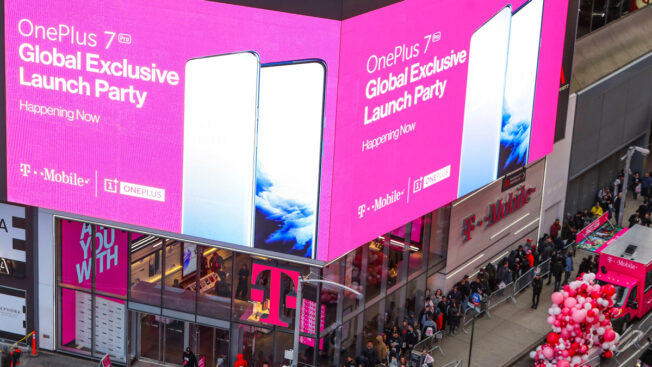Mark your calendar for Mediaweek, October 29-30 in New York City. We’ll unpack the biggest shifts shaping the future of media—from tv to retail media to tech—and how marketers can prep to stay ahead. Register with early-bird rates before sale ends!
T-Mobile Advertising Solutions dove into its first IAB NewFronts with a focus on retail media and streaming, as well as a plan to reach 240 million consumers and marketers through its screens.
The company kicked off its announcement of broader T-Mobile Advertising offerings at Moonlight Studios in New York by declaring that it is starting a retail media network within its more than 11,000 T-Mobile and Metro by T-Mobile locations throughout the U.S. The upwards of 20,000 retail media screens installed at those locations would supplement mobile ads offered to more than 7 million customers through T-Mobile’s T Life application.
eMarketer estimates that U.S. retail media ad spending will hit $54 billion this year, with some counting over 200 retail media networks. While Amazon has long mastered this space, multiple retail media efforts from companies including Best Buy, Instacart and Target’s Roundel have made inroads with consumers as third-party cookies begin to crumble.
According to Jean-Paul Colaco, senior vice president and chief T-Ads officer at T-Mobile—who has previously served as head of ads at WarnerMedia and Hulu—more than 28 million people come through T-Mobile’s various stores each month. Those customers would be targeted by retail media network ads using anonymized T-Mobile consumer data and through the T Life app. Members among them would be offered T-Mobile Tuesday perks that—as the company divulged at NewFronts—are now open to third-party brands.
“We have millions of people who are coming in and giving us consent to use their data, and that becomes a seed of data that we can use to project a universe and create better targeting,” Colaco said. “[On] T-Mobile Tuesdays, you can come in and showcase your brand to the millions of people who come in every Tuesday, and they actually take actions: They’ll save the actual offer. They’ll come to your retailer. They’ll bring their families. They’ll have a real impact on sales.”
Finally, T-Mobile Advertising announced that it is partnering with ad-supported streamer Plex to use its audience data to personalize ads and, eventually, content like movies and series for consumers.
Plex has more than 22 million monthly active users in more than 180 countries around the world. T-Mobile Advertising sees Plex, the T-Mobile retail media network, the T Life app and other offerings as a chance to grow the company’s multichannel marketing ecosystem—with Plex potentially providing T-Mobile-branded experiences and customers sharing their connected TV behaviors through T-Mobile logins.
“There’s also [Plex] working with us on how the mobile phone talks to CTV, and can we create bespoke interesting, innovative types of solutions for customers that make the mobile phone a centerpiece of a CTV experience,” Colaco said.
The big magenta picture
Mike Katz, T-Mobile’s president of marketing, strategy and products, kicked off the company’s first NewFronts appearance by bringing out its Super Bowl commercial star Common—who claimed he’s “noticed more for T-Mobile commercials now than anything”—and touting the influence T-Mobile’s wealth of data and its position at the event as one of the Top 10 advertisers in the country.
“It’s not just that we’re another vendor like, you know, pitching other ad products into the marketplace. We’re actually a big participant in this marketplace ourselves,” Katz said. “It’s a testament to our commitment to understanding and solving the real challenges that advertisers face every day, because we’ve been facing them too for a long time.”
The retail media network and the Plex deal add sizable T-Mobile Advertising audiences to the millions of people who view the 55,000 T-Mobile Advertising-driven screens currently in U.S. ride-share vehicles. Colaco said T-Mobile plans to increase those ride-share screens to 100,000 by year’s end and noted that, through partners, T-Mobile’s out-of-home reach increases to roughly 700,000 screens across the U.S.
Combined with data from T-Mobile’s 119 million global subscribers—including what apps they use and their engagement levels with those apps—data culled through the various interconnected sources that T-Mobile Advertising calls its Magenta Advertising Platform give the company information about more than 240 million consumers through its screens. T-Mobile considers that information especially valuable domestically, where 75% of time U.S. consumers spend online is dedicated to either their phones or streaming video.
At a time when, according to T-Mobile, consumers are seeing thousands more ads than they did two decades ago—with just 20% being relevant to them—the company sees its expanding ad infrastructure as essential to providing a more efficient marketing message for brand partners.
While T-Mobile still treads cautiously with its Magenta Advertising Platform—noting that the app ownership and engagement data it uses to build profiles of movie geeks or coffee lovers comes from anonymized first-party data, and that it asks users to opt into data-collection elements of its T Life app (and opt out of targeted ads)—its advertising wing can be an effective first-party data source.
T-Mobile Advertising pointed to its experience during the most recent Super Bowl, when a food-delivery app that advertised during the Big Game wanted to use CTV and online video to get more life out of its Super Bowl ad. T-Moble Advertising used its data to reach 852,000 incremental new households, increase consideration by 18.6%, boost reuse of its dormant app on users’ devices by 23% and lift new app installations by 6%.
“We can be a conduit. We can be a trusted source between consumers and marketers,” Colaco said. “We get a ton of data from [our] customers that—in a privacy-centric way, with the advent of data and artificial intelligence—we can use to get the right ad to the right person at the right time. … That’s why we want to sit in the middle of that ecosystem.”











